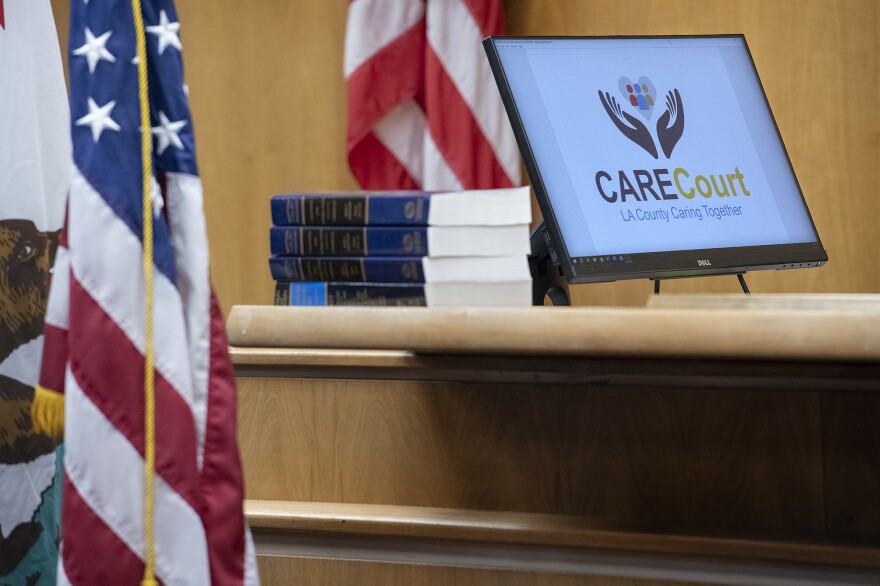With our free press under threat and federal funding for public media gone, your support matters more than ever. Help keep the LAist newsroom strong, become a monthly member or increase your support today.
How is California’s big plan to get help for people living with mental illness going in LA? Depends on who you ask

The number of people in Los Angeles County who participated in the first year of a program aimed at providing court-led treatment plans for people who live with serious mental illness remains far below initial state projections, according to data from county mental health authorities.
Known as CARE Court, the new program was promised as an innovative approach to bringing thousands of Californians living with untreated serious mental illness under the care of mental health professionals.
But numbers from the Los Angeles County Department of Mental Health show the county received about 16% of the petitions it was projected to get during the first six months of the program. From December of last year through mid-November, 308 petitions were filed in L.A. Superior Court, authorities said.
The petition numbers from Orange and Riverside counties are similarly low compared to estimates of how many people in those areas are potentially eligible for CARE Court.
“It’s been very frustrating to watch the slow pace of petitions by anyone other than family members,” Lisa Dailey, executive director of the Treatment Advocacy Center, a group that advocates for policies that benefit people living with serious mental illness, told LAist. Still, Dailey has hope for the program and thinks it deserves more effort.
Some critics see the paltry engagement as indicative of a failed policy. But supporters say the program needs more time and effort from county behavioral health departments.
Gov. Gavin Newsom, who championed the new approach, said he’s proud to see “early achievements,” including some 1,400 people throughout the state who were connected to CARE Courts or county services directly.

State officials estimated before the program’s launch that it could help between 7,000 -12,000 Californians a year.
Slow progress
CARE Court allows family members, behavioral health workers, first responders and others to ask a court — by way of a petition — to step in with a voluntary care plan for someone living with serious mental illness, like schizophrenia. If the plan fails, the person could be hospitalized or referred to a conservatorship.
Between Dec. 1, 2023 and Nov. 20, there were 308 petitions filed in Los Angeles County, far below the roughly 1,900 state officials projected for the first six months of the program. Of those, 28 participants signed on to agreements and four moved forward to the stage in which they were expected to receive a CARE Plan, ordered by the Superior Court.
Some experts say that progress has been slow, particularly in a county where thousands of people living with serious mental illness sleep on the streets every night.
The 2024 Point-In-Time count found that 24% of unhoused people over the age of 18 self-reported that they live with a serious mental illness, according to the Los Angeles Homelessness Services Authority, which conducts the annual count.
Martin Jones, a program manager with the L.A. County Department of Mental Health, said there are about 70 county staffers working on CARE Court. He said working with human beings — gaining their trust and establishing a rapport — takes time and that just physically getting someone to court can take multiple staffers.
“I think that we’ve seen a lot of success from individuals who we’ve been told if CARE had not intervened this person would have died on the streets,” Jones said. “How do you really calculate the value of those kinds of stories? And I believe that it’s incalculable.”
Jones said he expected the first wave of L.A. County CARE Court graduations to happen early next year.
How counties stack up on CARE Court
- Los Angeles:
Petitions: 308
Petitions dismissed: 89
Plans and/or agreements: 32 - Riverside:
Petitions: 105
Petitions dismissed: 24
Plans and/or agreements: 28 - Orange:
Petitions: 83 (received by OC Health Care Agency)
Plans and/or agreements: 6
‘A very narrow niche’
For Alex V. Barnard, author of the book Conservatorship: Inside California’s System of Coercion and Care for Mental Illness, the lackluster CARE Court numbers were all too predictable.
“It was clear from the beginning that this was a program that would be very hard to access, and would serve a very narrow niche,” Barnard wrote in an email to LAist.
Eligibility criteria for CARE Court state that a participant must be diagnosed with a psychotic spectrum disorder, like schizophrenia. Bipolar disorder is not included. The criteria also say that the participant can’t be in ongoing treatment.
Barnard said he predicts that CARE Court will remain a small piece of the mental health treatment landscape, overshadowed by what was known as Senate Bill 43, a new state law that expands the criteria for involuntary treatment.
The measure, signed by Newsom in October 2023, changed state law to allow people living with a serious mental illness or severe substance use disorder who are unable to provide for their personal safety or medical care to be deemed “gravely disabled” and held against their will.
Barnard also questions whether the multi-million dollar investment in CARE Court might have been better spent on beds and services, which the county is severely lacking.
“It's really not clear why you need a court to get mental health departments to provide mental health care to individuals with mental health challenges, though, versus fixing issues around financing and prioritization within that system,” he said.
‘A policy failure’
Eve Garrow, senior policy analyst with the American Civil Liberties Union of Southern California, said funding directed towards CARE Court should instead be going to community-based care. The low participation numbers are evidence to her that the effort is not working.
“I think by any measure, I would say the CARE Act to date is a policy failure,” Garrow said. “It’s used precious resources — public funds — to fund a court system that is not even being used.”
In 2022, 40 groups — including JusticeLA, Disability Rights California and ACLU California Action — signed a letter saying the program would strip “people with mental health disabilities of their right to make their own decisions about their lives.”
Garrow said she believed CARE Court was the wrong response to a very real problem: “Which is people with serious mental health disabilities -- many of whom are unhoused -- living without access to the care and services they need,” she said.
In her experience, Garrow said, most people who are offered quality mental health care will accept it voluntarily.
More time
Still, other mental health policy watchers are sticking by CARE Court, even if its initial expansion has been sluggish.
Dr. Susan Partovi, a family physician who does street outreach with the L.A. Centers for Alcohol and Drug Abuse, said the low participation may be partly because the Department of Mental Health needs to make more people aware of CARE Court and who it might help.
“I think they really need to be advertising this on a regular basis, because it’s hard to remember,” Partovi said, adding that the underwhelming numbers were a reminder for her that she could be filing more petitions.
According to the L.A. County Department of Mental Health, just 10 petitions came from provider networks.
Dailey, with the Treatment Advocacy Center, said county efforts have been partly to blame for what she sees as “unfortunate” numbers in the program’s first year. Jones, with the Department of Mental Health, said the county was now making a push to train more first responders on how to file petitions and when they might be appropriate. Only 22 of L.A. County’s 308 petitions were filed by the county Department of Mental Health.
The overwhelming majority came from family members.
“If there was no need for it, you wouldn’t see this initial rush from family members to try to get people into care,” Dailey said.











